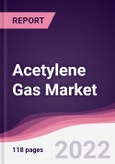Acetylene Gas Market size is estimated to reach USD 10.72 Billion by 2027, after growing at a CAGR of 4.87% during 2022-2027. The market is primarily driven by significant growth in the chemical industry, as well as rising global industrialization. Acetylene gas is widely utilized in metalworking applications such as oxyacetylene cutting, heat treatment, soldering, brazing, and welding due to its high flame temperature qualities. The combination of oxyacetylene and oxygen allows faster piercing and preheating than typical oxygen-based fuels.
This results in improved cutting quality, speed, and cut initiation time, resulting in increased efficiency and wider gas use throughout industries. Additionally, acetylene gas is used to make a variety of compounds, including acetic anhydride, acetic acid, and acetaldehyde. Carbon coating also finds use in the glass and materials processing sectors, since it aids in the creation of lubrication between the material surfaces. Other factors, such as intensive research and development (R&D) operations aimed at producing gas from biogas and other bio-based fuels, are also boosting market expansion.
This product will be delivered within 2 business days.
This results in improved cutting quality, speed, and cut initiation time, resulting in increased efficiency and wider gas use throughout industries. Additionally, acetylene gas is used to make a variety of compounds, including acetic anhydride, acetic acid, and acetaldehyde. Carbon coating also finds use in the glass and materials processing sectors, since it aids in the creation of lubrication between the material surfaces. Other factors, such as intensive research and development (R&D) operations aimed at producing gas from biogas and other bio-based fuels, are also boosting market expansion.
This product will be delivered within 2 business days.
Table of Contents
1. Acetylene Gas Market - Market
2. Acetylene Gas Market - Executive Summary
3. Acetylene Gas Market - Comparative analysis
4. Acetylene Gas Market - Startup Companies Scenario Premium
Methodology

LOADING...








